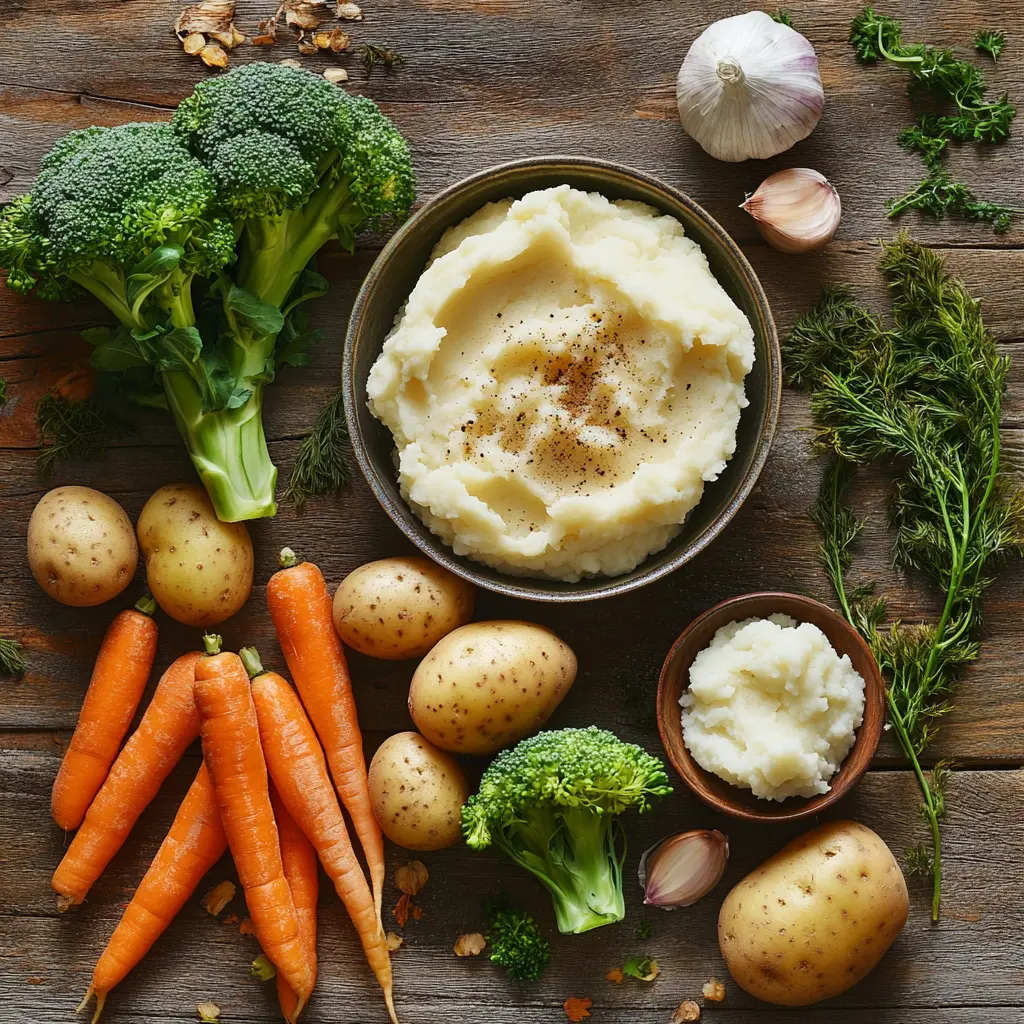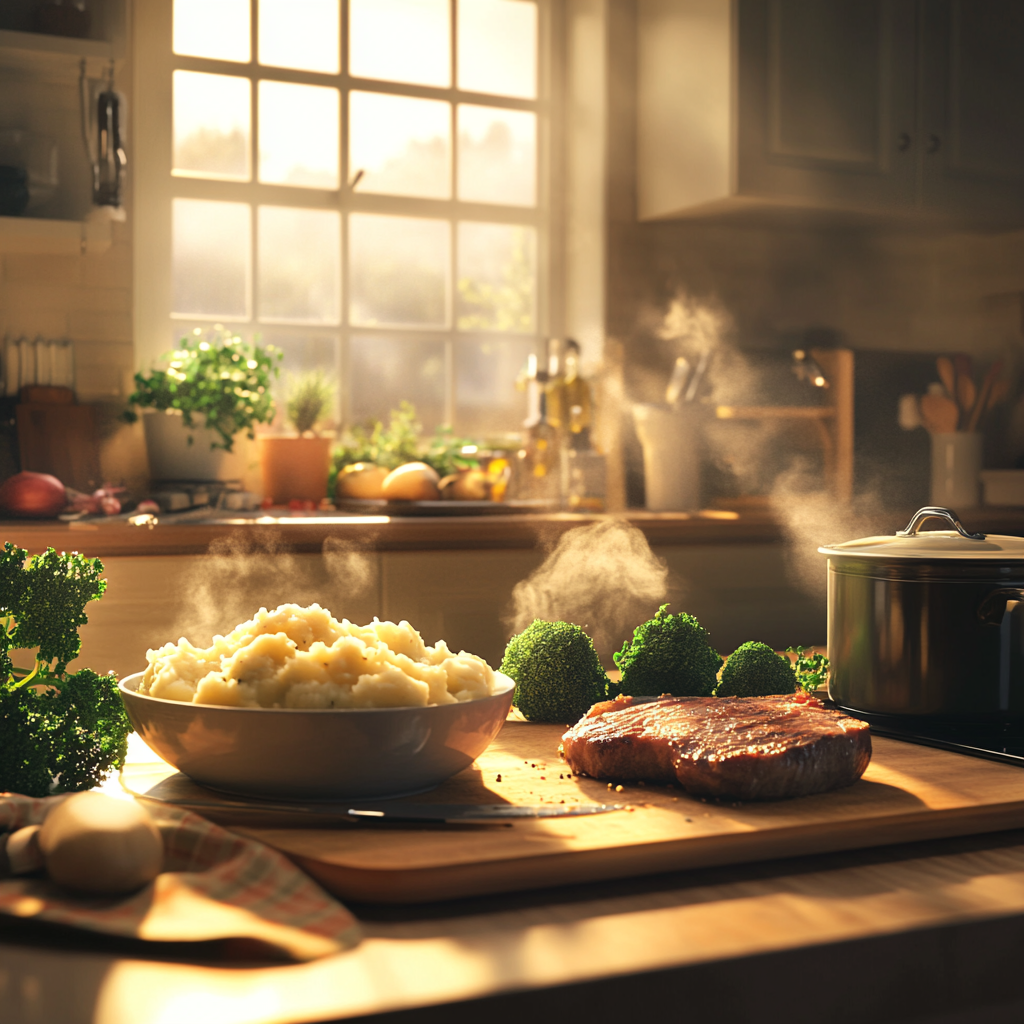How Much Fiber Is in Steak, Mashed Potatoes, and Broccoli?
Eating well is about balance, and fiber plays a key role in staying healthy. But when enjoying comfort foods like steak, mashed potatoes, and broccoli, how much fiber are you actually getting? This article breaks down the fiber content in these favorites and offers ways to make your meal even healthier. You’ll learn how to tweak recipes to pack in more nutrients while keeping things tasty. Let’s dig into the facts and strategies!
Table of Contents
Understanding Dietary Fiber and Its Importance
What Is Dietary Fiber?
Dietary fiber is a type of carbohydrate that your body can’t digest. Instead of breaking it down, fiber moves through your system, helping it stay in tip-top shape. It’s found in plant-based foods like vegetables, grains, and fruits.
Fiber isn’t just one thing—it’s grouped into two categories:
- Soluble fiber: This dissolves in water and forms a gel-like substance. It helps lower cholesterol and stabilize blood sugar.
- Insoluble fiber: This doesn’t dissolve and adds bulk to your stool, making digestion smoother.
A balanced diet usually has both types to support overall health.
Types of Fiber: Soluble and Insoluble
Eating both soluble and insoluble fiber gives your body multiple benefits. Soluble fiber, for example, is found in foods like oats and beans, while insoluble fiber is common in broccoli and potato skins. Each works in its own way to boost digestion and prevent issues like constipation.
When planning meals, aim for variety. Combining foods like steak, mashed potatoes, and broccoli can give you a mix of both types.
Why Fiber Matters for Your Diet
Fiber is like a superhero for your gut. It keeps things moving and can even help with weight management by making you feel full longer. Fiber-rich foods are often less calorie-dense, so you can enjoy more without going overboard.
Plus, diets high in fiber can lower your chances of getting serious health conditions like heart disease, diabetes, and some cancers. While steak, mashed potatoes, and broccoli aren’t all equally rich in fiber, small changes to how you prepare them can make a big difference.

Fiber Content in Steak, Mashed Potatoes, and Broccoli
How Much Fiber Does Steak Contain?
Steak is a beloved protein, but when it comes to fiber, it doesn’t offer much. Fiber is only found in plant-based foods, meaning meat like steak has none. However, steak pairs well with high-fiber sides, which helps create a more balanced plate.
While steak doesn’t contribute to your fiber goals, its iron and protein can be part of a healthy diet. To make the meal work better nutritionally, you’ll want to add vegetables or grains rich in fiber.
Analyzing Fiber in Mashed Potatoes: Skin or No Skin
Mashed potatoes are a classic side, but they aren’t very high in fiber unless you keep the skins. A single cup of mashed potatoes typically has about 2 grams of fiber. However, that number doubles when you leave the skin on.
The potato skin is where much of the fiber lives. For instance, a medium potato with the skin has around 4 grams of fiber. Without it, you lose the bulk of this nutrient. Wondering how much fiber is in steak mashed potatoes and broccoli together? A meal with mashed potatoes made with skin and broccoli can boost fiber significantly.
Broccoli as a Fiber Powerhouse
Broccoli stands out as a great source of fiber. One cup of cooked broccoli contains about 5 grams of fiber. This makes it one of the best choices to pair with lower-fiber foods like steak and mashed potatoes.
Broccoli also brings other benefits to the table, like vitamins C and K, as well as antioxidants. Whether you steam, roast, or sauté it, this green vegetable adds both taste and nutrition to your meal.
Comparing Their Fiber Contributions
When combined, steak, mashed potatoes, and broccoli create a meal that varies in fiber depending on how you prepare it. Steak doesn’t add any, mashed potatoes can range from 2 to 4 grams, and broccoli contributes a hefty 5 grams.
Altogether, a plate with skin-on mashed potatoes and a serving of broccoli gives you about 9 grams of fiber. That’s a solid step toward the daily goal of 25 grams for women or 38 grams for men.
Recipes to Maximize Fiber in Your Meal
Making High-Fiber Mashed Potatoes: Additions and Tweaks
To make mashed potatoes healthier, consider leaving the skin on. Another trick is mixing in high-fiber ingredients like lentils or shredded vegetables such as carrots or zucchini. These add both texture and extra fiber.
Sweet potatoes are another great swap. They offer more fiber—about 4 grams per cup—and bring a slightly sweet flavor that pairs well with savory dishes. Try blending half sweet potatoes with regular ones for a unique twist.
Fiber-Rich Ways to Cook Broccoli
Cooking broccoli the right way can help retain its fiber. Steaming is a great method because it keeps the texture intact and the nutrients locked in. Adding garlic or a squeeze of lemon can brighten its flavor without loading on unhealthy fats.
If you prefer roasting, toss broccoli with a little olive oil and spices. This method caramelizes the edges, adding depth to its taste while keeping the fiber content high.
Protein and Fiber Combo: How to Prepare Steak
Steak might lack fiber, but how you serve it can make all the difference. Pairing it with high-fiber sides like broccoli and potatoes creates a balanced meal. Marinating steak with herbs and spices, instead of sugary sauces, keeps it flavorful and heart-healthy.
You can also slice steak thinly and toss it into a grain bowl with quinoa or brown rice. Both are rich in fiber and offer a nutty flavor that complements the meat.
Pairing These Ingredients for a Balanced Plate
Creating a high-fiber plate doesn’t mean sacrificing flavor. Start with a serving of steak, add skin-on mashed potatoes, and finish with a hearty portion of broccoli.
To go even further, sprinkle some ground flaxseed or chia seeds on the potatoes for an extra fiber boost. This combination not only answers the question of how much fiber is in steak mashed potatoes and broccoli but also ensures a meal that’s as satisfying as it is nutritious.

Frequently Asked Questions (FAQs)
Is There Fiber in Meat Like Steak?
No, meat, including steak, doesn’t contain any fiber. Fiber only comes from plant-based foods. However, steak can still be part of a nutritious meal if you pair it with high-fiber sides like mashed potatoes (with skin) and broccoli. These combinations help balance the meal while keeping it flavorful and satisfying.
How Can I Add Fiber to Low-Fiber Foods?
If you’re wondering how much fiber is in steak mashed potatoes and broccoli, the numbers can vary based on preparation. Adding fiber-rich ingredients is key. For example:
Use sweet potatoes instead of regular ones in mashed potatoes.
Leave potato skins on for extra fiber.
Toss roasted or steamed broccoli with nuts or seeds for a crunchy fiber boost.
These small tweaks make a big difference in your fiber intake.
Do Sweet Potatoes Have More Fiber Than Regular Potatoes?
Yes! Sweet potatoes contain about 4 grams of fiber per cup, which is double the fiber in regular mashed potatoes made without skins. Besides, sweet potatoes bring added nutrients like beta-carotene, which supports eye health.
Does Cooking Broccoli Reduce Fiber?
Cooking broccoli slightly softens its texture but doesn’t significantly lower its fiber content. Steaming or roasting are great ways to retain the most nutrients and fiber. Avoid boiling broccoli for too long, as overcooking can make it less appealing and nutrient-rich.
What’s the Best Way to Cook Steak, Mashed Potatoes, and Broccoli Together?
For a well-rounded meal, try grilling steak for a smoky flavor, mashing potatoes with their skins, and steaming broccoli lightly. Combining these elements maximizes taste and fiber content without complicating the recipe.
For more ideas on combining steak with sides, check out Alexia Recipes’ guide on steak and potatoes.
Tips for Boosting Fiber Intake in Meals
Simple Swaps to Increase Fiber
Small changes can go a long way in improving your meal’s fiber content:
- Replace white bread or pasta with whole-grain versions.
- Add vegetables like carrots or spinach to mashed potatoes.
- Choose fiber-rich snacks like nuts, seeds, or fresh fruits instead of processed options.
These swaps are easy to make and don’t compromise flavor.
Incorporating Fiber Into Everyday Cooking
Cooking with fiber in mind doesn’t have to be hard. For instance, add chia seeds or ground flaxseed to dishes like mashed potatoes. Stirring in beans or lentils to soups or stews also increases fiber content without much effort.
Eating meals with balanced fiber levels helps your body stay healthy. With dishes like steak, mashed potatoes, and broccoli, you can make small changes that add up over time.
For more fiber-rich meal ideas, check out Alexia Recipes’ Ultimate Guide to Steak and Mashed Potatoes here.
